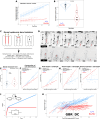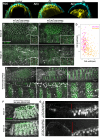Automorphy as a self-organizing DPP-dependent process that translates patterns into mechanical programs during Drosophila embryogenesis
- PMID: 40577454
- PMCID: PMC12204166
- DOI: 10.1126/sciadv.adv0311
Automorphy as a self-organizing DPP-dependent process that translates patterns into mechanical programs during Drosophila embryogenesis
Abstract
Morphogens provide developing tissues with positional information to ensure coherent morphogenesis. Bone morphogenetic proteins (BMPs) initially form a gradient to pattern the dorsal domains of the Drosophila embryo. Here, we show that the BMP homolog decapentaplegic (DPP) endows dorsal domains with specific mechanical programs to organize morphogenesis. These domains self-organize using high local DPP activities, a process we call automorphy. Automorphy is key to inducing specific morphological changes while being faithful to the initial positional information. The BMP morphogen therefore uses a series of automorphic events to translate each position into physical potentials that later produce a contractile amnioserosa and a dorsal epidermis displaying plasticity. Plasticity allows cell elongation in wild-type embryos, and perturbations of cellular patterns reveal its crucial role in adapting to mechanical constraints. We propose that gradient formation and automorphy constitute complementary processes that allow BMPs to act as a morphogen in the Drosophila embryo.
Figures





Similar articles
-
A minimal vertex model explains how the amnioserosa avoids fluidization during Drosophila dorsal closure.Proc Natl Acad Sci U S A. 2025 Jan 7;122(1):e2322732121. doi: 10.1073/pnas.2322732121. Epub 2024 Dec 30. Proc Natl Acad Sci U S A. 2025. PMID: 39793057 Free PMC article.
-
Control of fate specification within the dorsal head of Drosophila melanogaster.Development. 2024 Aug 15;151(16):dev199885. doi: 10.1242/dev.199885. Epub 2024 Aug 27. Development. 2024. PMID: 39190554 Free PMC article.
-
A role for Myosin in triggering and executing amnioserosa cell delaminations during dorsal closure.Sci Rep. 2025 Sep 1;15(1):32160. doi: 10.1038/s41598-025-16032-2. Sci Rep. 2025. PMID: 40890388 Free PMC article.
-
Gradients and thresholds: BMP response gradients unveiled in Drosophila embryos.Trends Genet. 2003 Dec;19(12):701-8. doi: 10.1016/j.tig.2003.10.009. Trends Genet. 2003. PMID: 14642751 Review.
-
The Decapentaplegic morphogen gradient: from pattern formation to growth regulation.Nat Rev Genet. 2007 Sep;8(9):663-74. doi: 10.1038/nrg2166. Nat Rev Genet. 2007. PMID: 17703237 Review.
References
-
- Turing A. M., The chemical basis of morphogenesis. Philos. Trans. R. Soc. Lond. Ser. B Biol. Sci. 237, doi.org/10.1098/rstb.1952.0012 (1952). - PMC - PubMed
-
- Wolpert L., Positional information and the spatial pattern of cellular differentiation. J. Theor. Biol. 25, 1–47 (1969). - PubMed
-
- Briscoe J., Sussel L., Serup P., Hartigan-O’Connor D., Jessell T. M., Rubenstein J. L. R., Ericson J., Homeobox gene Nkx2.2 and specification of neuronal identity by graded Sonic hedgehog signalling. Nature 398, 622–627 (1999). - PubMed
-
- Jessell T. M., Neuronal specification in the spinal cord: Inductive signals and transcriptional codes. Nat. Rev. Genet. 1, 20–29 (2000). - PubMed
MeSH terms
Substances
LinkOut - more resources
Full Text Sources
Miscellaneous

